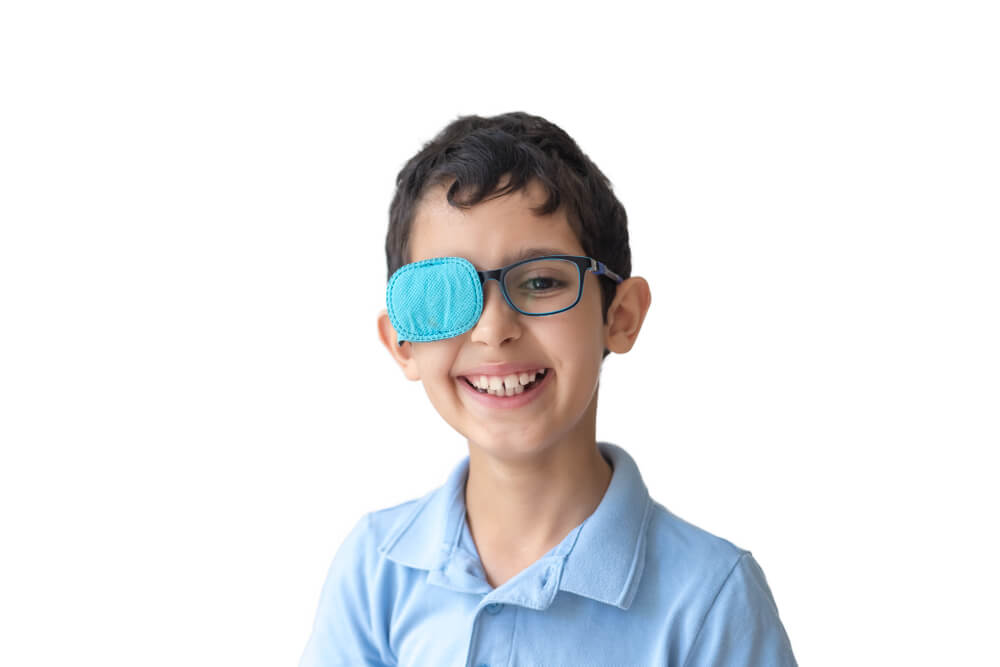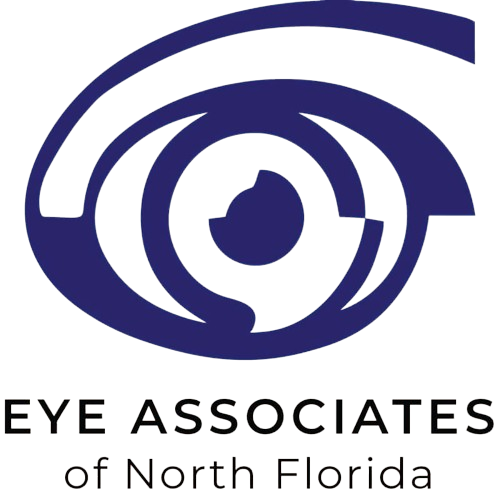Children’s Eye Exams In Tallahassee, FL
There are many visual tests that can be performed to assess your child’s vision. It’s important for your pediatric ophthalmologist to test the strength of the eyes as a team and independent of each other. Engaging and pleasant tests are done to determine the health of your child’s eyes. One of the key ways of assessing the need for glasses or contact lenses is the use of dilating drops to examine the eye. Once these drops have taken effect, your doctor can measure the focusing error of the eyes and determine the overall health of the eyes through the use of specialized equipment.
Depending on the type of eye drop used, the duration of effect can last from two hours to one to two days, with most patients staying dilated for several hours. Until the dilating medicines wear off, your child will have difficulty seeing at near-distances. Some individuals of a lighter colored iris tend to stay dilated longer than average. Sunglasses are a helpful means to limit the sensitivity to bright sunlight.

Strabismus & Amblyopia
These are two common vision problems in children. If not treated, these problems can permanently affect a child’s eyesight. A child will not outgrow strabismus or amblyopia, but both can be treated. Early eye exams and the right treatment can improve a child’s vision.
Strabismus
Strabismus occurs when a child’s eyes are not aligned (straight). This means the eyes do not work together, which can prevent normal vision from developing. If it is not treated it can lead to amblyopia.

What is amblyopia?
It is a poor vision that occurs when the brain ignores one or both eyes. This often means only one eye is being used. If not treated early, amblyopia may keep a child from developing normal vision.
When the eyes don’t work together, the brain has trouble interpreting what’s being seen. Things that can keep the eyes from working together are:
- Alignment problems (strabismus) one eye looks in a different direction from what it’s trying to see. This may be constant (all the time) or intermittent (some of the time).
- Focusing problems – one or both eyes have trouble focusing. The brain receives blurry pictures. Focusing problems include being:
- Nearsighted – distant objects appear blurred
- Farsighted – near objects appear blurred
- Astigmatism – both near and distant objects appear blurred
Most children should have their first eye exam by the time they start school. At the doctor’s visit, evaluation of health history will be performed. This is to determine if health problems could be affecting the child’s vision.
- Testing vision is the next step in the process. The testing of visual acuity is to find out how well the child’s eyes see and whether the eyes have trouble focusing.
- The doctor will test for binocular vision, to see whether the child’s eyes are working together and whether the brain is fusing images.
- He will also test eye movement to see how well the child’s eyes move and whether they move together.
- He will then test eye alignment to see if the child’s eyes are aligned and are focusing together.
If a diagnosis of strabismus is given, this means the eyes are not aligned. One eye may turn in, out, up or down, while the other looks straight ahead. When the eyes aren’t aligned, pictures sent to the brain are too different to be fused into one image.
What Causes Strabismus?
There are 2 main causes:
- focusing problems (such as being farsighted) this can cause an eye to turn in when trying to focus
- eye muscles that are unable to keep the eyes aligned
What is esotropia?
This is an eye that turns in and is sometimes called being “cross-eyed”.
What is exotropia?
This is when an eye turns out and is sometimes referred to as being “wall-eyed”.
Treatments For Strabismus
This is done by correcting the problem that’s making the child’s eyes turn.
- wearing eyeglasses
- surgery is sometimes needed to align the eyes and treat strabismus
- patching is occasionally done to strengthen the vision
The doctor’s goal for treatment would be to:
- correct the problem that’s causing the eyes to turn
- align the eyes
- improve sight in both eyes as much as possible
- make the eyes work together
Strabismus In Adults
Most adult strabismus is simply persistent childhood strabismus. Strabismus which occurs in adulthood without a history of childhood eye misalignment should be evaluated carefully for medical or neurological causes such as diabetes, thyroid disease, myasthenia gravis, brain tumors, or strokes.
What are the symptoms of adult strabismus?
If strabismus has been present since childhood, symptoms are usually minimal. If the strabismus develops late in childhood or as an adult, the most common symptom is double vision.
What causes double vision?
When the eyes are misaligned each eye sees a separate image.
How is adult strabismus treated?
There is a common misconception that strabismus is difficult or impossible to treat. Actually, adults with strabismus have many treatment options including:
- prism glasses
- eye muscle surgery
- oculinum injections
An adult does not need to live with misaligned eyes. Advances in techniques allow excellent chances of improved alignment and appearance for most individuals.
Amblyopia
Amblyopia is when the brain ignores signals coming from one eye. Over time, the brain gets used to working with only one eye. The eye being ignored doesn’t develop normal vision. Making the brain use both eyes and getting the eyes to work as a team becomes harder as the child grows. It is best to treat it as soon as possible.
What Causes Amblyopia?
- poor vision in one eye
- strabismus
Treatment for amblyopia is most often treated by blocking one eye to keep it from doing all the work. The brain can learn to accept signals from the eye that’s being ignored. Gradually, vision may improve.

Methods Of Treatment
- Patching – an eye patch is placed over the eye that’s being used. With the eye-patched, the brain is forced to start working with the eye it’s ignoring. The doctor will instruct how to patch.
- Medicated eye drops – Atropine is an eye drop that can be used instead of patching. Drops are put in the eye that’s being used, blurring vision in that eye to keep it from doing all the work.
- Eyeglasses – can help correct focusing problems. They can also be prescribed to blur sight in the eye that’s being used. This forces the brain to work with the eye it’s ignoring. In some cases, sight in one eye is blocked by sticking a patch or a filter to the inside of an eyeglass lens. As vision improves, the child’s eyeglass prescription may change.
As the child’s vision improves, their treatment needs may change. But the goals stay the same: to help each eye see as well as it can, and to allow both eyes and the brain to work as a team. Treatment may take weeks or months. At follow-up visits, the doctor will check how well treatment is working. Techniques make it possible to test vision in infants and young children. If there is a family history of misaligned eyes, childhood cataracts, or serious eye disease, an eye doctor should examine the eyes during infancy.
Eye Injuries
Eye injuries that are preventable are a major cause of vision loss in the United States. Eye injuries can occur at any time, and nearly 50% of all eye injuries occur in sports and recreation activities. It is imperative that children wear appropriate safety glasses during sporting activities as well as any activities in which the eye may be struck by a foreign object. If your child experiences a chemical injury, it is imperative that immediate irrigation with water is started. Any available sources appropriate, and the eye should be flushed at least ten minutes and urgent care sought immediately. If a sharp object has struck the eye or there is fear that a small object, such as a BB, has penetrated the eye, seek immediate care at the nearest emergency room. It is important at first to cover the child’s eye and ensure that he or she refrain from rubbing the eye.
Corneal Abrasion
A corneal abrasion is a scratch of the outermost layer of the eye. The “skin” of the eye is 0.05 millimeters (50 microns) thick and though quite tough, it can be scratched with relatively minor trauma. The abundance of sensory nerves in this region can lead to significant pain with the occurrence of a corneal abrasion.
Corneal abrasions are treated with eye drops, ointments, a patch, or even a specialized contact lens. Your ophthalmologist will observe closely during the healing phase of a corneal abrasion to assess for the possibility of infection. Corneal abrasions generally heal quite fast and often are resolved in one to three days.
Rarely, a condition called corneal erosion occurs after corneal abrasion. This condition is generally more common in adults and involves the spontaneous occurrence of abrasion without any preceding trauma. Corneal erosions occur because there is a faulty connection between the outermost layer of the cornea and its underlying tissue. Erosions most commonly occur in the middle of the night or upon awakening and can be successfully treated.
Conjunctivitis
Conjunctivitis, or “pink eye” is a condition in which the eye becomes red and irritated, and is usually caused by a viral infection. The conjunctiva is a clear thin membrane that covers the white portion of the eye and also lines the inner eyelids. Inflammation of the conjunctiva is called conjunctivitis. Symptoms of conjunctivitis include crusting of the eyelids and lashes, tearing, and generalized eye irritation. A watery or mucoid discharge usually accompanies conjunctivitis. Most cases of conjunctivitis in the pediatric population are caused by viruses, and bacteria may also be a source of infective conjunctivitis. Non-infectious agents such as allergies or chemical exposure (e.g., sunscreen) can cause conjunctivitis.
Viral Conjunctivitis
Just as there are no available drugs to combat the common cold, there are no suitable eye drops to treat viral conjunctivitis. With viral conjunctivitis, your doctor may recommend that the infection “run its course” and allow the body’s natural defense system to fight off the infection. Sometimes antibacterial eye drops are prescribed as a means to prevent secondary bacterial infection. The overuse of antibiotics in humans and livestock has lead to increased antibiotic resistance, so don’t be alarmed if unnecessary antibiotic eye drops are not prescribed for your child’s viral infection. If antibiotic drops are prescribed it is important to follow directions and complete the full course of treatment.
Conjunctivitis is typically quite contagious, especially the viral subset. The infection is easily transferable through hand to eye contact as well as sneezing and coughing. We remind children not to touch their eyes, mouths, or noses in general, and especially during cold and flu season.
In general, most cases of conjunctivitis are mild and resolve without complications. There are some forms of bacterial conjunctivitis that can lead to vision-threatening complications, especially in newborns. It is important to contact your pediatrician or your pediatric ophthalmologist if an infection is severe.
Note also that some newborns develop eye tearing, and this phenomenon is typically due to a temporarily blocked tear duct, called a nasal lacrimal duct obstruction. Eye tearing may also be caused by more serious ocular conditions, such as infantile glaucoma and corneal infections, and it is important to contact your physician if your baby has these symptoms.
Styes & Chalazia
A stye, also known as a hordeolum, is an acute infection of the glands at the base of the eyelids and eyelashes. They occur when oil glands become clogged and infected. Styes present as a red, painful bump on the eyelid. Large styes may cause blurred vision as well.
Styes frequently resolve on their own without treatment. Warm compresses and topical medications can be very helpful and hasten resolution.
Chalazia
A chalazion is a chronic cyst within the eyelid. These lesions tend to be less irritated and painful than a stye, and reflect a chronic issue. Chalazia arise spontaneously but frequently occur after the acute phase of a stye. Once the acute infection of the stye resolves, residual oils and inflammatory material create a chalazion cyst.
A chalazion is typically a painless swelling of the eyelid. These lesions may cause blurred vision if they become large, a fairly common issue with chalazia.
Treatment initially involves warm compresses to attempt to soften and shrink the lesion, and your doctor may also prescribe topical medications to help treat it. If the chalazion doesn’t go away, your eye doctor may need to remove the lesion in the office.
Cataracts
Cataracts are caused by a clouding of the internal lens of the eye. Typically associated with older adults, cataracts can be a pediatric issue as well. Children born with congenital cataracts may develop severe and permanent vision loss. A particularly cloudy cataract will block the formation of a clear view of the retina of the eye. Without a clear image on the retina, the brain will not obtain good visual information of the world. Timely diagnosis and treatment are imperative in cases of, particularly cloudy cataracts. Cataracts vary greatly in their amount of visual effect.
Causes Of Congenital Cataract
The lens of the eye starts to form around day 21 of pregnancy, and any intrauterine abnormality then or after may effect proper eye formation. Some cases are inherited and others may be due to metabolic problems.
Treatment Of Cataracts
Not all cataracts require treatment. Particularly dense cataracts require urgent treatment, whereas milder forms require simple observation to ensure that amblyopia does not occur. If surgery is indicated, a small incision is made on the eye and the cloudy lens is removed. Sometimes an artificial lens, called an intraocular lens, is inserted into the eye. With or without this lens replacement, glasses or contact lens are often prescribed to improve proper focusing.







